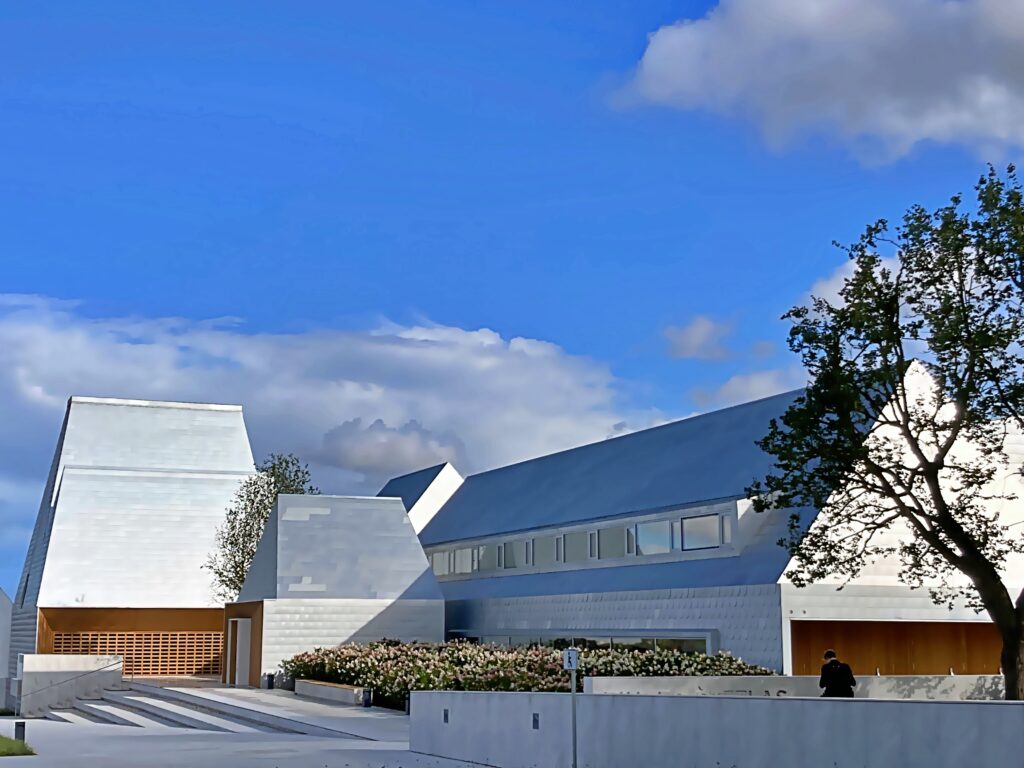
By Inna Rogatchi
August 2025
Respectful Memory & Decency of Civility: Commemoration in Seduva
On 25th August 1941 the Jewish life of one of so many shtetl places in Lithuania, in Seduva, was annihilated. About 700 children, women, elderly and men were cruelly and energetically murdered in the nearby forest.
Eighty four years later, to the date, the time of three and half generations, many people from all around the world whose roots are from Lithuania, and even precisely from Seduva, gathered in the place which is more than two hours drive from Vilnius, to commemorate the solemn date, and to see in advance the new memorial museum which will open in September 2025.
It is a very special project, Lost Shtetl Museum and Memorial complex that includes a lovingly restored cemetery and meditative comforting park around the truly remarkable complex of buildings, with smashing in many senses interior design and permanent exhibition.
When visiting Lithuania among three Baltic states with an official visit in the beginning of August 2025, the President of Israel Isaac Herzog, whose grandmother is from the place, have spent several hours with his wife Michal at the special mezuzah fixing ceremony of the door of the Lost Shtetl Museum.
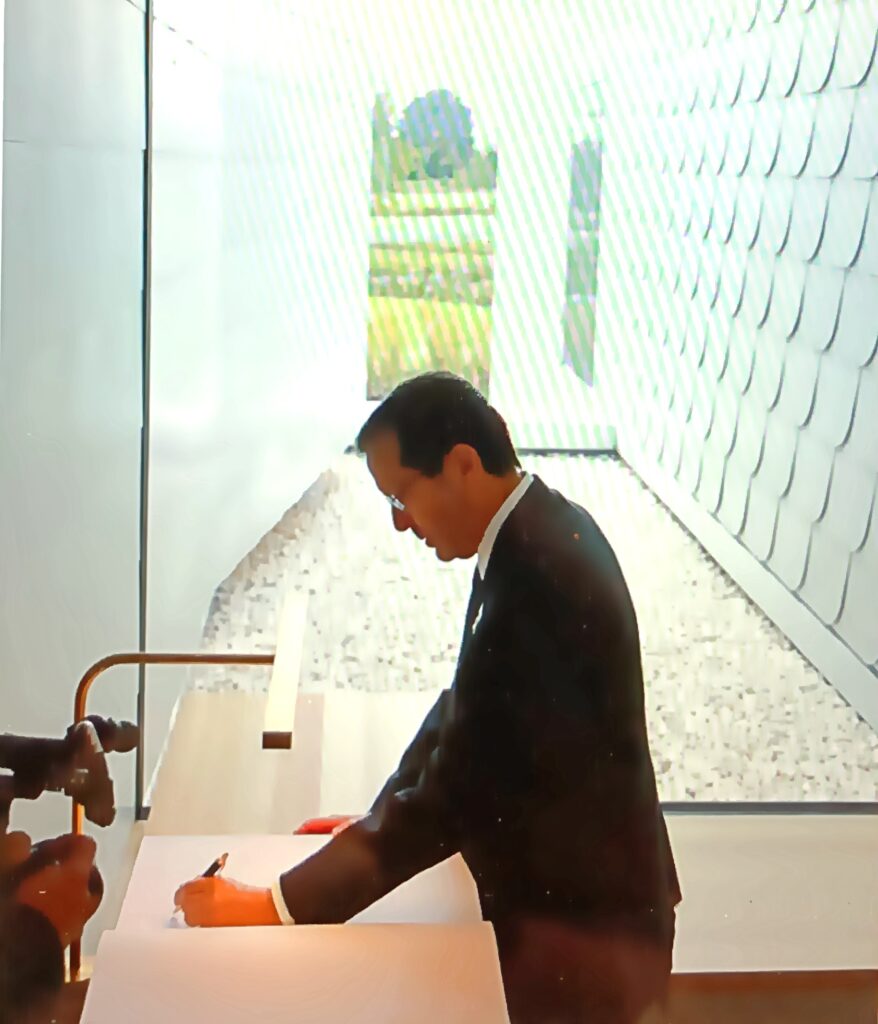
After a detailed two-hour tour through its premises and the core exhibition, President Herzog called the museum ‘outstanding’. He had a good reason for this praise.
* * *
My husband artist Michael Rogatchi and I were glad to be able to participate in that cordial, touching, warm and dignified commemoration that gathered so many so different people, including the descendants of the Lithuanian Jews from Toronto to New Mexico and from Cape Town to London, Lithuanian top politicians, Members of the European Parliament, Ambassadors and distinguished diplomats, important representatives of the leading international Holocaust and Jewish institutions, such as Yad Vashem and POLIN, historians , leaders of the cultural life in Lithuania, international stars of music in its different genres.
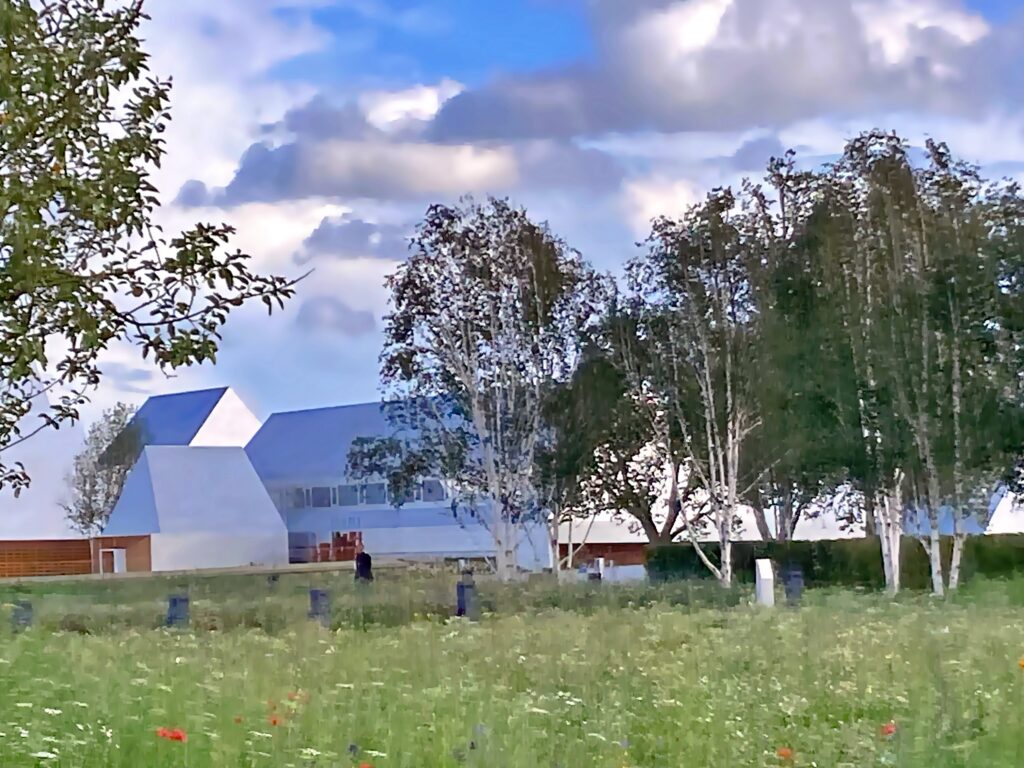
The one thing that has united all those different people from all around the world was interest, with a capital I. Their all and each of them genuine interest towards what we all were seeing around and in front of us: the complex of buildings which makes a special, distinctive statement in its modernity and elegance, the trademarks of our great Finnish architect professor Rainer Mahlamäki who authored the project, cutting-edge interior and permanent exhibition design by world-famous RAA, Ralph Appelbaum Associates company, soothing park around the building produced by also quite well-known in its field ENEA, that truly special completely restored, to be ready in 2013 after a three-years work, Jewish cemetery nearby. All together it works and impresses very different people, and not necessarily with a Jewish background, in a deeply humane way.
In all this, a huge service to the Jewish memory and civilised history has been done, and hopefully, the museum will continue to produce that special atmosphere of quiet compassion and respectful, caring remembrance which actually builds our own, each one’s individually, status of civility and decency.
* * *
We came to see the fruit of almost 10-years hard work of our dear colleague professor Rainer Mahlamäki and his dedicated, talented and reliable team, our friends and colleagues from very able Lahdelma & Mahlamäki Architects Finland, and their Lithuanian colleagues, and to be with Rainer and his wife Maria at that special commemorative event and on that day.
We both were very glad to see the people’s unanimous fantastic reaction to the complex of buildings, its harmonious architectural decision, its modernity, its articulated messages, its metaphors, and its light which is the main proponent in everything what Rainer creates, even – and even more so – when he deals with the darkest and most difficult historical themes.
Symbols of the Heart: Modern Architecture of Memory
There are very rare architects who are able to create a harmonious co-existence of distinctively different domains, such as modernity and sharpness of contemporary architecture from one side, and living nature from the other.
Professor Rainer Mahlamäki is one of those rare architects whose vision have created both beautiful and humane new reality that can be seen in both of his important buildings appeared in a decade between them, POLIN Museum in Warsaw opened its doors in 2014, and recently we all celebrated its 10th anniversary, and new Lost Shtetl Museum in Seduva, Lithuania, will be opened in September this year.
These two photographs of mine, also taken in a decade between them, captured that vision of the architect. The vision that actually creates a new reality, which is and will be imprinted in the perception and will stay in memory of so many.

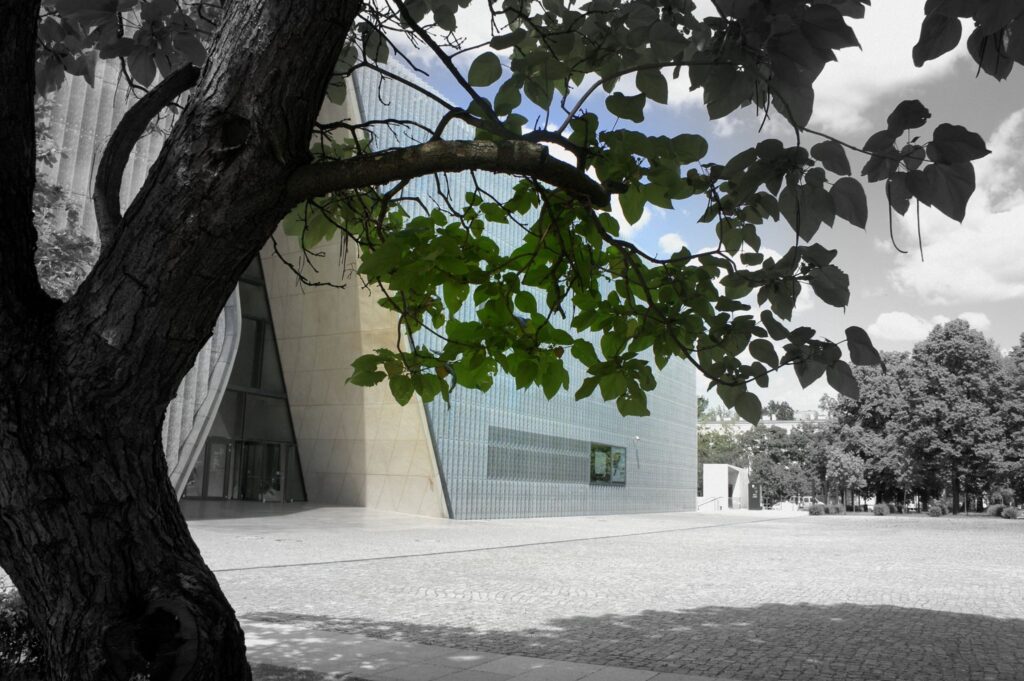
This new reality, which is a harmonious creation, importantly, yet is more and specifically meaningful in the cases of the buildings that houses both incredibly rich but also bottomlessly tragic history, as it is the cases of both POLIN and Lost Shtetl museums.
These beautiful and emblematic trees in the front of the POLIN and Lost Shtetl museum facades indicate life, and strive for life, ongoing living memory, continuity, and the thread of humanity.
It has created a special, authored by Rainer Mahlamäki spatial reality. It has also created a new space in both places. The space which speaks to one directly. The space of humanity.
Canyon of Hope & Message of Light: Essential Features of the new museum in Lithuania
The Lost Shtetl Museum and Memorial Complex in Seduva is a purposefully accommodative building, architecturally. It was done by its author, well-known Finnish architect professor Rainer Mahlamäki, with an attentive care, to create, or as Rainer emphasises, “to re-create the life that has been annihilated”.
Coming close to the building which is situated in an open airy place in the Lithuanian country-side, one feels very comfortable, immediately. This is also one of the trade-marks of Rainer Mahlamäki’s architecture, his wish and ability to create not just a place, but the place of comfort, psychologically as well. And one can feel it in practically all Rainer’s buildings. This is a special focus and a special talent, undoubtedly.
But this architect, who is a deep and strong intellectual, is not satisfied with one dimension in his architecture, far from it. Entering the building of the Lost Shtetl Museum, one is getting surprised almost instantly, and then non-stop.
The main element of this surprise is the building’s openings. Visitors of the museum are facing them in several places, and every time, the effect of opening works with no mistake.
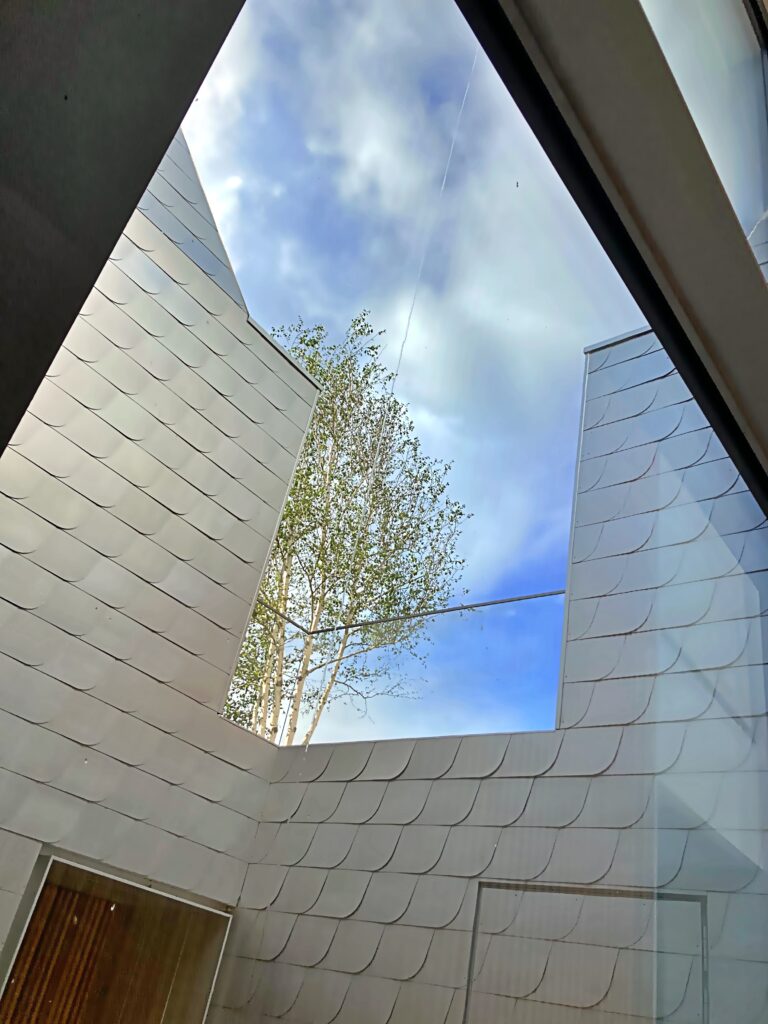
An opening effect in architecture is a tricky thing. If an architect fails in it, it will be counter-productive, and it would be felt as unnecessary, something like a seasonal decoration that has been forgotten to be taken away in time.
But if the opening, especially inside the modern building, is done with vision and masterly, it adds to the building , and to a visitor’s impression of the building in a big way, with a long-lasting reflection. The Lost Shtetl Museum building in this respect is very successful and very special indeed.
There are several openings in the Lost Shtetl museum, not too little and not too much. They are all different. Being an organically talented person, Rainer Mahlamäki possesses a special quality of not repeating himself and the elements of his design. In some of the openings, we are seeing all elements of living nature: skies, trees, plain calm landscape in some instances.
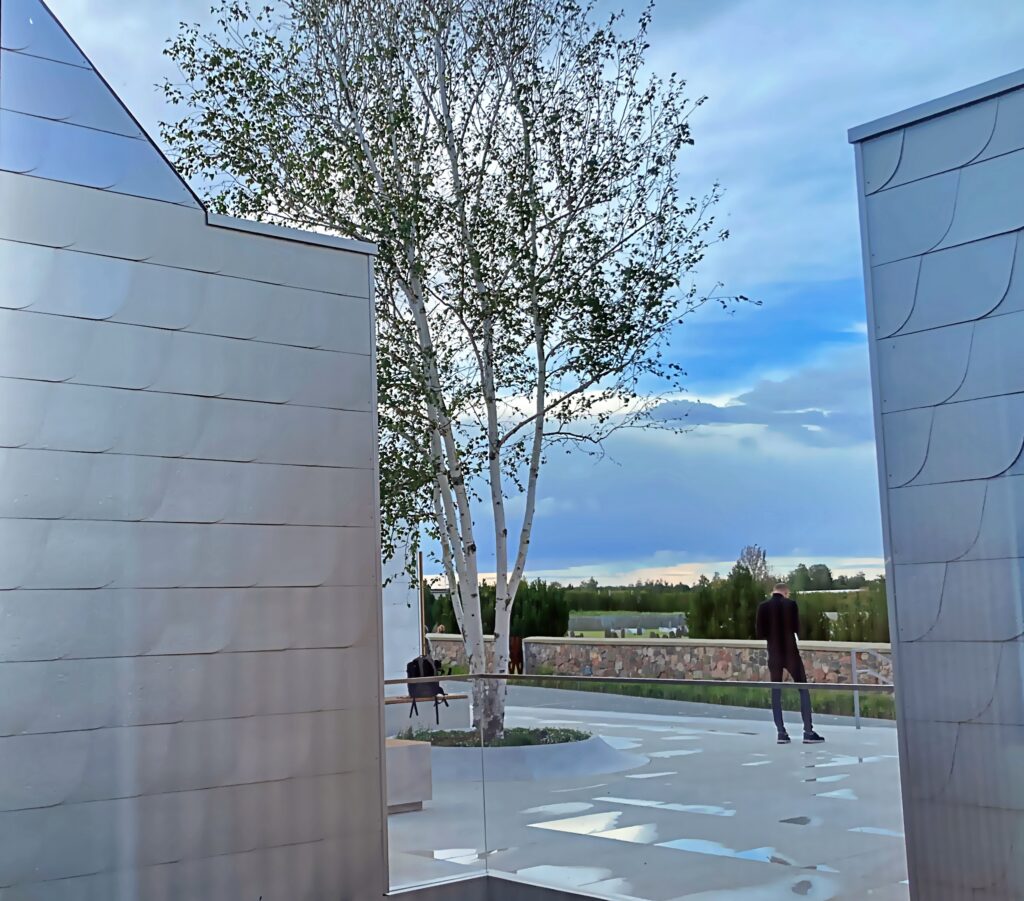
This creates the dialogue between a visitor and the building momentarily, and this instant interconnection sets up a dialogue for a visitor during his elaborate and rather uneasy travelling through quite intense permanent exhibition of the museum that tells about the life which is not ‘simply’ not anymore, but which has been interrupted and destroyed brutally and with unlimited cruelty.
Rainer’s Canyon of Hope in this museum in my opinion should bring him a very substantial international architectural prize, indeed.
I have been following this project since the beginning, for almost a decade by now, and I knew about this unique element of the building design all these years on. But nothing, just nothing can prepare one for experiencing this sensation in reality.
Not only does the Canyon of Hope lead people to the skies after a rather uneasy walk through the museum’s galleries. It hovers over the meticulously restored Jewish cemetery which is located just nearby the museum’s building. This Canyon of Hope is a grandiose success of Rainer Mahlamäki’s building of the Lost Shtetl Museum, and I am sure that it will become its re-sounding symbol.
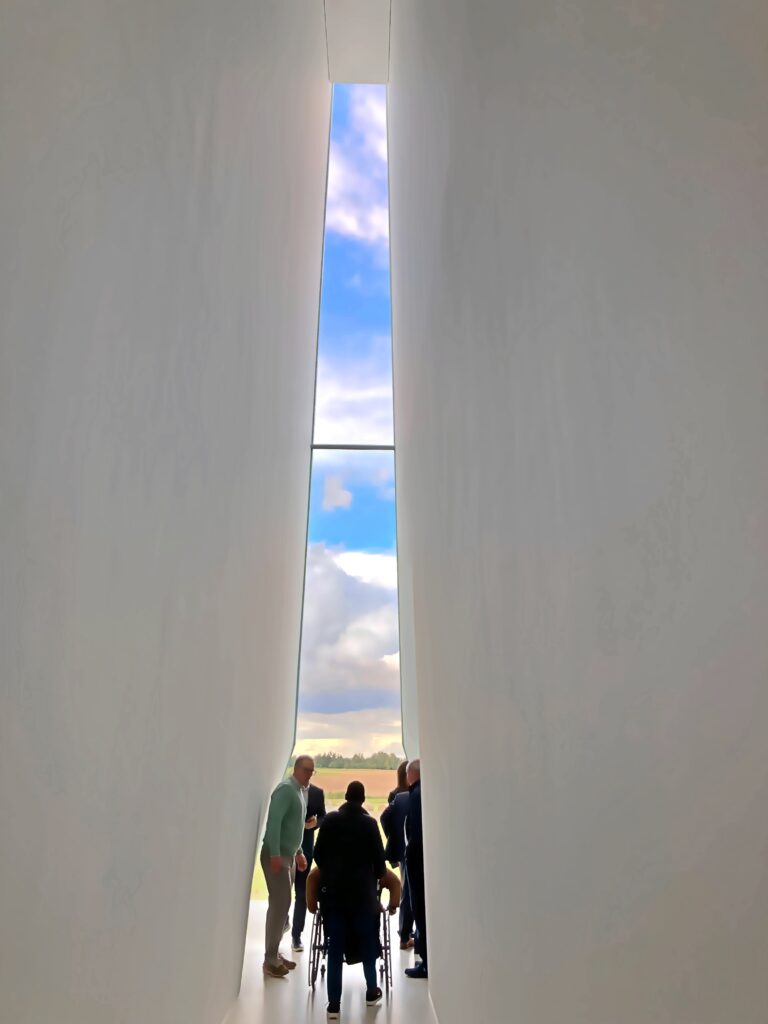
As if this high-class architectural philosophy created by professor Mahlamäki and implemented so well by his Lahdelma & Mahlamäki Architects Finland and their Lithuanian colleagues would not be enough, the master architect provides a very smart architectural dialogue in the museum’s Canyon space. The opposite of the great Canyon of Hope, there is another canyon and another opening. I call it Canyon-2.
It is very high and it is designed in the same coloristic key, thus making the dialogue of two canyons organic and natural. But the window of the canyon-2 is a fraction of the size of the Canyon of Hope’s opening, and it is placed incredibly high, in the way that one needs a push of extra attention to notice it. The message that the dialogue between the two canyons creates is gentle and meditative, also due to the spatial but also metaphorical and psychological completeness of the space.
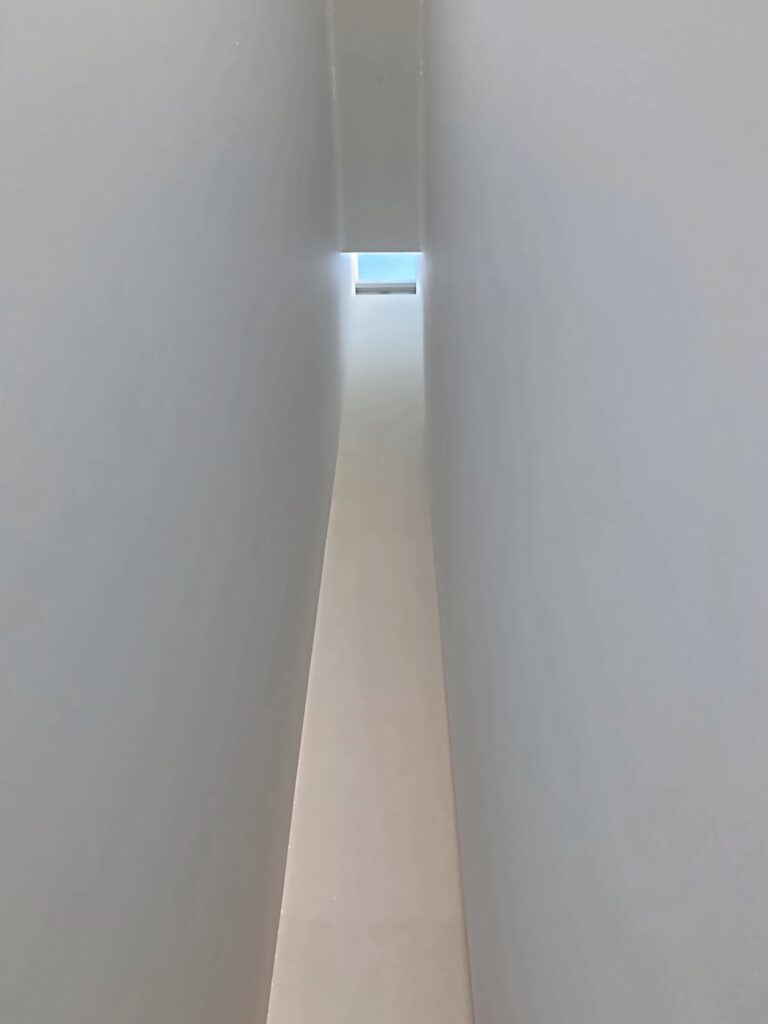
The space created by those two canyons opposing each other is like a special stratum, the special place to think. And think again. The canyon-2 idea has a connotation with the opening in the powerful Daniel Liebeskind’s Jewish Museum in Berlin. But it is quite different.
In Berlin, the place of the opening is the place of barely controllable horror in a stylised prison cell. One is so impressed there that many people instinctively inclined to forget it, to take it away from their consciousness, because it is objectively very difficult to bear. Not many succeed though, because Liebeskind’s decisions in the Jewish Museum in Berlin are very powerful indeed.
In the Lost Shtetl Museum, the window opening of the canyon-2 opposing the long vertical opening of the Canyon of Hope, is placed much higher, curved not directly, but with Mahlamäki’s trade-marked beautiful curves, as he applied in the POLIN building, thus making the space immediately comforting, and inviting mediation.
The space of two canyons in the Lost Shtetl is as if it embraces you, it supports you. This is a rare sensation in modern architecture, doubly so when the subject is the Holocaust.
And there was not a single person among those who visited the museum on the special commemorative event honouring the memory of the victims of Jews of Seduva murdered in August 1941, who would not spend a substantial time in the Canyon of Hope.
That space works miraculously. It is not about Hope Against Hope. It is about Hope as an element. And this is what life is about.
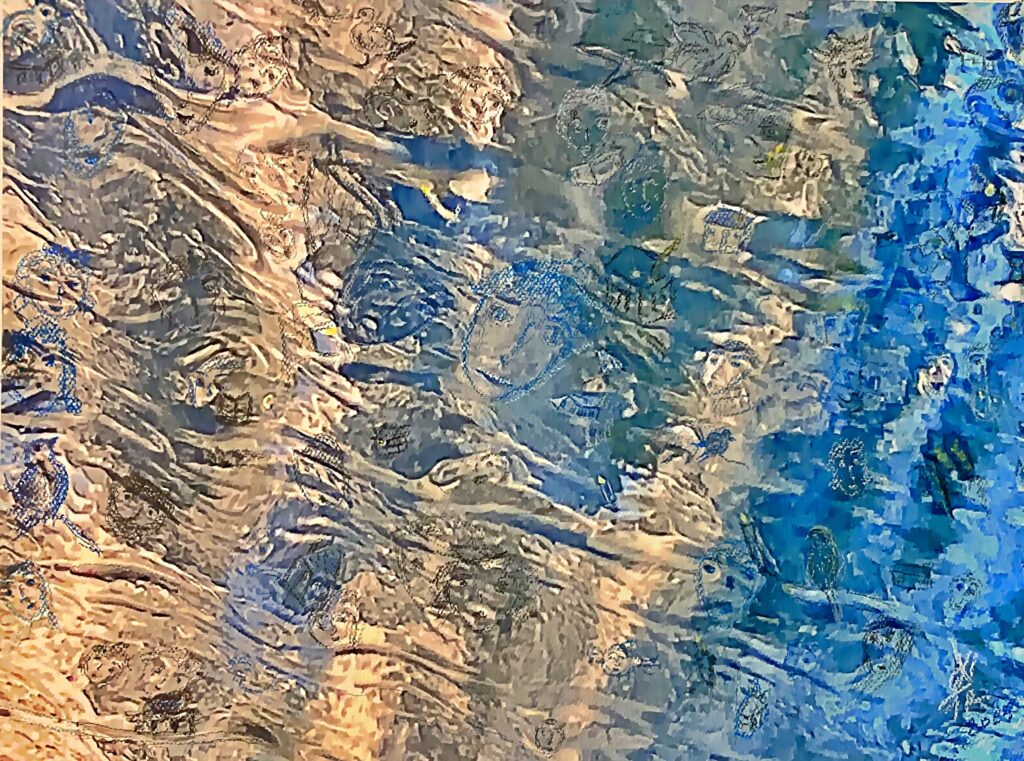
With cordial Thank You to all and everyone who has made this special and important project of respectful and loving memory, in its almost decade-long journey of creation, happened. It is a meaningful contribution to humanity, and it is highly appreciated.
August 2025
Seduva – Vilnius – Helsinki
